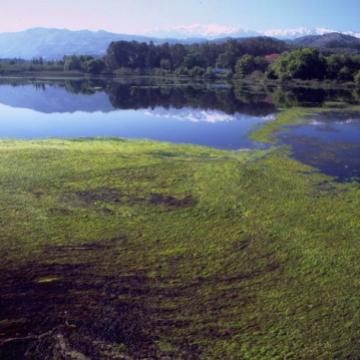GR4340006 - LIMNI AGIAS - PLATANIAS - REMA KAI EKVOLI KERITI - KOILADA FASA
Map
Quality
The quality and importance of Agia lake and Keritis stream estuary is due to the following: 1) The limited number of freshwater bodies in Crete. 2) the important role of freshwater biotopes for the water balance and the biodiversity of the island of Crete. 3) the importance of the wetland as a refugee for many bird species. 4) the variety of habitat types. 5) the high degree of diversity both in animal and in plant species. The presence of the endemic species Podarcis erhardii cretensis is important, as Crete is the southern distribution limit for the restricted population of the species. 7) the geographical connection of the site with a quite biodiverse CORINE biotope, the White Mountains of Crete.Fasas valley, besides the importance of its wetland communities, is considered as having an excellent global value also because it consists the only habitat of the viviparous chain-fen, Woodwardia radicans (an Annex II species), in Greece and one of the very few in the Europe. W. radicans is protected by the Bern Convention (1992) and considered endangered in Greece and vulnerable in Europe while its world status is unknown (IUCN, 1993). Its single population in Crete is threatened by local agricultural development.OTHER IMPORTANT SPECIESWITH MOTIVATION DPlants:Orchis laxiflora marked with the letter D is protected by Greek legislation (Presidential Decree 67/1981).
Other characteristics
The site is situated at the northeastern part of Crete, west of Chania.The coastal part includes Platanias, a sandy beach, and the estuary of Keritis stream. Inland the site continues along Keritis stream and it includes the artificial lake of Agia. Although it is not a natural lake, it supports a varied selection of wetland communities (probably the most varied in the Cretan area). On the south the site reaches to Fasas valley.According to the historical data, in the past there was a small bog at the same place where the artificial lake exists today. Agia's hydrological basin is different from the one of Keritis and includes the slopes north of Vathipetro village. Xekolomenos stream on the east supplies the lake with water. The lake is also supplied on the west side by some underground springs originating from Keritis stream. At the periphery of the wetland, large stands of Phragmites australis are important for the structure of the lake ecosystem. On the southern part of Agia the Public Enterprises of Water Supply and Draining of Chania is installed. Close to the installations there are two large stands of Eucalyptus tostrata and Pinus brutia. Keritis stream has a permanent flow only at its southern part -after the lake of Agia- where it is supplied by the lake's water; its upper part has an intermittent flow. Keritis estuary is structures mainly by Phragmites australis while on the beach there are sand dunes dominated by Ammophila arenaria. Potamogeton luceus, Potamogeton trichoides, Callitriche cophocarpa are species important for the ecological balance and the structure of the coastal sand dunes. The southern part of the site, Fasas valley, probably the most humid valley of Crete, is characterised by linear wetland habitats, particularly well developed. In the upstream part of the valley along the river there are three vegetation types of Brachypodio-Holoschoenion. Notably the steep wet schistose rocks harbour the Acrocladio-Adiantetum and particularly the species-rich variant Scirpus cernuus with many rare bryophytes. The ferns (a habitat type not included in Annex I) cover a small part of the site with excellent representativity and good conservation status.
Documentation
1) Patras University - Ministry of Environment, Physical Planning and Public Works. 1988. (Work Team: Economidou E. et al) Entopismos kai meleti ton ygroviotopon kai allon simantikon gia tin ornithopanida viotopon tis Kritis (Localization and study of wetlands and of other important for the birdfauna biotopes of Crete). Final report, Vol. 1, Patra. p. 384.
2) Kahman 1959. Beitrag zur Kenntnis der fledermausfauna aus der Inseln Kreta. Saugetierk. Mit. 7: 153-157.
3) Ministry of Environment Physical Planning and Public Works. 1990. (Work Team: A. Legakis et al). Erevnitiko programma. Meleti ton akton tis kritis pou parousiazoun oikologikes diatarahes (Research Programme. Study of the coasts of Kriti that present ecological disturbances). Dept. of Biology. University of Crete, p. 228.
4) Turlad N.J., Chilton L. & Press J.R. 1993. Flora of the Cretan area. Annotated checklist & atlas. p.439.
5) Pohle 1952. Uber fledertieze von Kreta. Z. Saugetierk. 17(1): 14-20.
6) Morgan V & C. Leon. 1992. Datasheets of Flora species for revision of Appendix I of the Bern Convention. Volume II. Non-endemic and endemic taxa of Austria, Germany, Hungary, Norway and the United Kingdom. Nature and environment. Nature and Envrionment. No 61 p. 162. Council of Europe, Publishing and Documentaion Service, Strasbourg. (3.2.g., 4.2)
7) Gradstein S.R. & J.H. Smittenberg. The Hydrophilous vegetation of Western Crete. Vegetatio 34:65-86, 1977.
8) Georghiou K. 1995. Checklist of Endemic, Rare and Threatened Plants of Greece. Draft. University of Athens. (3.3, 3.4, 4.2)
Reference: Natura 2000 data form, database release 7 Feb 2014




